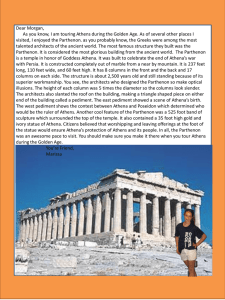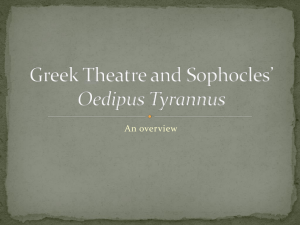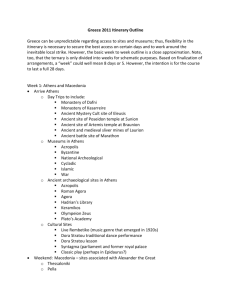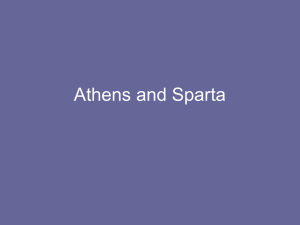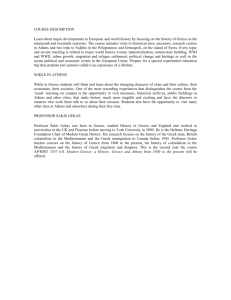Athens is the capital and largest city of Greece. Athens dominates
advertisement
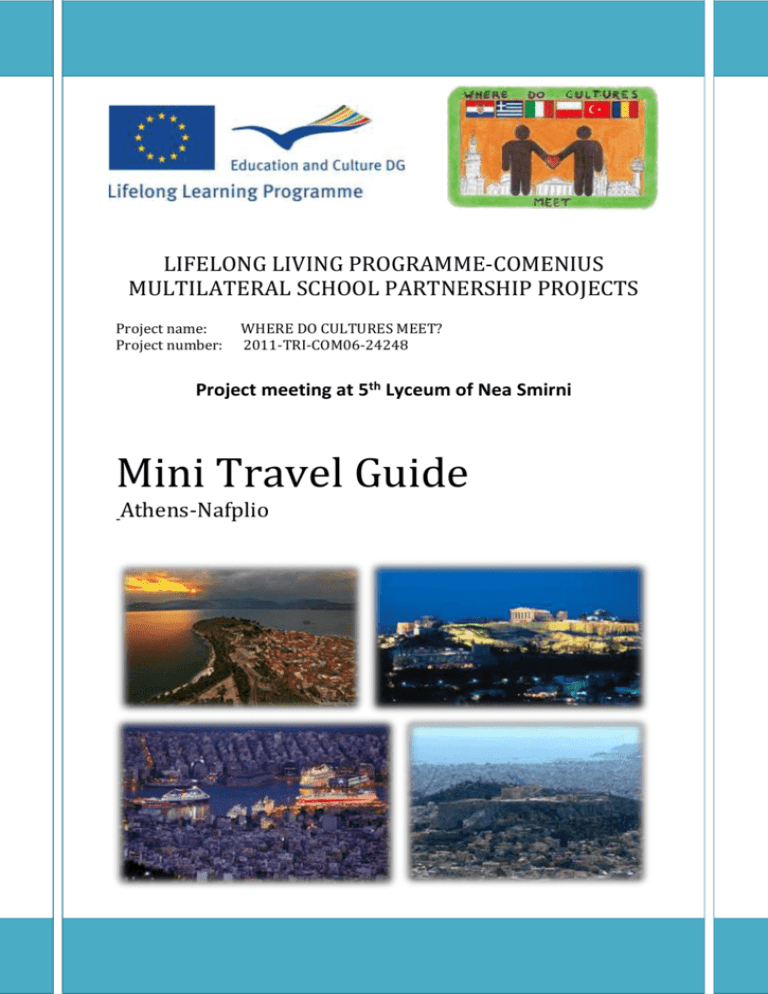
LIFELONG LIVING PROGRAMME-COMENIUS MULTILATERAL SCHOOL PARTNERSHIP PROJECTS Project name: Project number: WHERE DO CULTURES MEET? 2011-TRI-COM06-24248 Project meeting at 5th Lyceum of Nea Smirni Mini Travel Guide Athens-Nafplio Athens Athens is the capital and largest city of Greece. Athens dominates the Attica region and is one of the world's oldest cities, with its recorded history spanning around 3,400 years. Classical Athens was a powerful city-state. A centre for the arts, learning and philosophy, home of Plato's Academy and Aristotle's Lyceum it is widely referred to as the cradle of Western civilization and the birthplace of democracy largely due to the impact of its cultural and political achievements during the 5th and 4th centuries BC in later centuries on the rest of the then known European continent. Today a cosmopolitan metropolis, modern Athens is central to economic, financial, industrial, political and cultural life in Greece. In 2008, Athens was ranked the world's 32nd richest city by purchasing powerand the 25th most expensive in a UBS study. The city of Athens has a population of 4,013,368 Athens is also the southernmost capital on the European mainland. An etiological myth explaining how Athens acquired this name was well known among ancient Athenians and even became the theme of the sculpture on the West pediment of the Parthenon. Both Athena and Poseidon requested that they become patrons of the city and give their name to it, so they competed with one another for the honour, offering the city one gift each. Poseidon produced a salt water spring by striking the ground with his trident, symbolizing naval power. However, some myths suggest that he created horses out of sea foam as a gift for Athens. Athena created the olive tree, symbolizing peace and prosperity. The Athenians, under their ruler Cecrops, accepted the olive tree and named the city after Athena. Athens sprawls across the central plain of Attica that is often referred to as the Athens or Attica Basin (Greek: Λεκανοπέδιο Αττικής). The basin is bounded by four large mountains: Mount Aegaleo to the west, Mount Parnitha to the north, Mount Penteli to the northeast and Mount Hymettus to the east.[21] Beyond Mount Aegaleo lies the Thriasian plain, which forms an extension of the central plain to the west. The Saronic Gulf lies to the southwest. Mount Parnitha is the tallest of the four mountains , and has been declared a national park. Athens is built around a number of hills. Lycabettus is one of the tallest hills of the city proper and provides a view of the entire Attica Basin. The geomorphology of Athens is deemed to be one of the most complex in the world due to its mountains causing a temperature inversion phenomenon which, along with the Greek Government's difficulties controlling industrial pollution, was responsible for the air pollution problems the city has faced. This issue is not characteristic of Athens alone; for instance, Los Angeles and Mexico City also suffer from similar geomorphology inversion problems. Acropolis The Acropolis of Athens is an ancient citadel located on a high rocky outcrop above the city of Athens and containing the remains of several ancient buildings of great architectural and historic significance, the most famous being the Parthenon. Acropolis means "high city" in Greek. Although there are many other acropoleis in Greece, the significance of the Acropolis of Athens is such that it is commonly known as "The Acropolis" without qualification. The Acropolis was formally proclaimed as the preeminent monument on the European Cultural Heritage list of monuments on 26 March 2007. Parthenon The Parthenon is a temple on the Athenian Acropolis, Greece, dedicated to the maiden goddess Athena, whom the people of Athens considered their patron. Its construction began in 447 BC when the Athenian Empire was at the height of its power. East pediment The east pediment narrates the birth of Athena from the head of her father, Zeus. According to Greek mythology, Zeus gave birth to Athena after a terrible headache prompted him to summon Hephaestus' (the god of fire and the forge) assistance. To alleviate the pain, he ordered Hephaestus to strike him with his forging hammer, and when he did, Zeus's head split open and out popped the goddess Athena in full armour. The sculptural arrangement depicts the moment of Athena's birth. Unfortunately, the centrepieces of the pediment were destroyed even before Jacques Carrey created otherwise useful documentary drawings in 1674, so all reconstructions are subject to conjecture and speculation. The main Olympian gods must have stood around Zeus and Athena watching the wondrous event, with Hephaestus and Hera probably near them. The Carrey drawings are instrumental in reconstructing the sculptural arrangement beyond the center figures to the north and south. West pediment The west pediment faced the Propylaia and depicted the contest between Athena and Poseidon during their competition for the honor of becoming the city's patron. Athena and Poseidon appear at the center of the composition, diverging from one another in strong diagonal forms, with the goddess holding the olive tree and the god of the sea raising his trident to strike the earth. At their flanks, they are framed by two active groups of horses pulling chariots, while a crowd of legendary personalities from Athenian mythology fills the space out to the acute corners of the pediment.The work on the pediments lasted from 438 to 432 BC, and the sculptures of the Parthenon pediments are some of the finest examples of classical Greek art. The figures are sculpted in natural movement with bodies full of vital energy that bursts through their flesh, as the flesh in turn bursts through their thin clothing. The thin chitons reveal the body underneath as the focus of the composition. The distinction between gods and humans is blurred in the conceptual interplay between the idealism and naturalism bestowed on the stone by the sculptors. The pediments no longer exist. The Elgin Marbles The Elgin Marbles are a collection of classical Greek marble sculptures (mostly by Phidias and his assistants), inscriptions and architectural members that originally were part of the Parthenon and other buildings on the Acropolis of Athens. Thomas Bruce, the 7th Earl of Elgin obtained a controversial permit from the Ottoman authorities to remove pieces from the Parthenon while serving as the British ambassador to the Ottoman Empire from 1799 to 1803. Chryselephantine statue of Athena The Parthenon’s main function was to provide shelter for the monumental chryselephantine (made of gold and ivory) statue of Athena that was created by Pheidias and dedicated in 438 BCE. The statue stood approximately 9 or 11 meters (around 40 ft.) tall. It has not survived to our day, but we have enough accounts of its existence along with a number of smaller marble copies, including the one on exhibit at the National Museum of Athens. Athena stands holding a Nike (Victory) on her right hand that extends forward from the elbow, as if offering Nike to the Athenian citizens. With her left hand she supports her shield which shelters a snake as it rests on the ground, and her lance that rests on her left shoulder.She is dressed with an Attica peplos, and on her head she wears a richly decorated helmet with a sphinx at the apex and two Pegasi on each side. Her breastplate is adorned with snakes and the head of Medusa at the center. The statue was a hollow construction with a wooden armature that supported the outer surfaces of the golden drapery, and the ivory flesh of Athena. The statue was situated close to the south end of the cella and was surrounded by a procession of double-decked Doric columns on its flanks as well as the back. The floor of the cella in front of it was a shallow pool of water or oil, which added further drama to the statue’s context with its reflective surface. Mount Lycabettus Mount Lycabettus, is a Cretaceous limestone hill in Athens, Greece. At 277 meters above sea level, the hill is the highest point in the city that surrounds it. Pine trees cover its base, and at its two peaks are the 19th century Chapel of St. George, a theatre, and a restaurant. Zappeion The Zappeion is a building in the National Gardens of Athens in the heart of Athens, Greece. It is generally used for meetings and ceremonies, both official and private. Ancient Agora The Ancient Agora of Classical Athens is the best-known example of an ancient Greek agora, located to the northwest of the Acropolis and bounded on the south by the hill of the Areopagus and on the west by the hill known as the Kolonus Agoraios, also called Market Hill. Propylaea The monumental gateway to the Acropolis, the Propylaea was built under the general direction of the Athenian leader Pericles, but Phidias was given the responsibility for planning the rebuilding the Acropolis as a whole at the conclusion of the Persian Wars. According to Plutarch, the Propylaea was designed by the architect Mnesicles, but we know nothing more about him. Construction began in 437 BCE and was terminated in 432, when the building was still unfinished. Old Temple of Athena Nike The Temple of Athena Nike is a temple on the Acropolis of Athens. Built between 427 and 424 BC, the temple is the earliest fully Ionic temple on the Acropolis. It has a prominent position on a steep bastion at the south west corner of the Acropolis to the right of the entrance, the Propylaea. In contrast to the Acropolis proper, a walled sanctuary entered through the Propylaea, the Nike Sanctuary was open, entered from the Propylaea's southwest wing and from a narrow stair on the north. Erechtheion The Erechtheion is an ancient Greek temple on the north side of the Acropolis of Athens. The temple as seen today was built between 421 and 406 BC. Its architect may have been Mnesicles, and it derived its name from a shrine dedicated to the legendary Greek hero Erichthonius. Athena Promachos The Athena Promachos ("Athena who fights in the front line") was a colossal bronze statue of Athena sculpted by Pheidias, which stood between the Propylaea and the Parthenon on the Acropolis of Athens. Athena was the goddess of wisdom and warriors and the protectress of Athens. Keramikos Keramikos is an area of Athens, Greece, located to the northwest of the Acropolis, which includes an extensive area both within and outside the ancient city walls, on both sides of the Dipylon. Gate and by the banks of the Eridanos River. It was the potters' quarter of the city, from which the English word "ceramic" is derived, and was also the site of an important cemetery and numerous funerary sculptures erected along the road out of the city towards Eleusis. Panathenaic Stadium The Panathenaic Stadium also known as the Kallimarmaro is an athletic stadium in Athens that hosted the first modern Olympic Games in 1896. Monastiraki Monastiraki is a flea market neighborhood in the old town of Athens, Greece, and is one of the principal shopping districts in Athens. The area is home to clothing boutiques, souvenir shops, and specialty stores, and is a major tourist attraction in Athens and Attica for bargain shopping. Plaka Pláka is the old historical neighborhood of Athens, clustered around the northern and eastern slopes of the Acropolis, and incorporating labyrinthine streets and neoclassical architecture Hellenic Parliament The Hellenic Parliament is the Parliament of Greece, located in the Parliament House (Old Royal Palace), overlooking Syntagma Square in Athens. It is a unicameral legislature of 300 members, elected for a four-year term. Sounion Cape Sounion is noted as the site of ruins of an ancient Greek temple of Poseidon, the god of the sea in classical mythology. The remains are perched on the headland, surrounded on three sides by the sea. The ruins bear the deeply engraved name of English Romantic poet Lord Byron. The site is a popular day-excursion for tourists from Athens, with sunset over the Aegean Sea, as viewed from the ruins, a sought-after spectacle. Theatre of Dionysus The Theatre of Dionysus Eleuthereus is a major open-air theatre and roman and one of the earliest preserved in Athens. It was used for festivals in honor of the god Dionysus. It is sometimes confused with the later and betterpreserved Odeon of Herodes Atticus, located nearby on the southwest slope of the Acropolis. Odeon of Herodes Atticus The Odeon of Herodes Atticus is a stone theatre structure located on the south slope of the Acropolis of Athens. It was built in 161 AD by the Athenian magnate Herodes Atticus in memory of his wife, Aspasia Annia Regilla. It was originally a steep-sloped amphitheater with a three-story stone front wall and a wooden roof made of expensive, cedar of Lebanon timber. It was used as a venue for music concerts with a capacity of 5,000. Thiseio Thiseio is the name of a neighborhood in downtown Athens, Greece, northwest of the Acropolis, 1.5 km southwest of downtown, and 1 km southwest of city hall; its name derives from the Temple of Hephaestus, also known as Τhiseio, as it was, in earlier times, considered a temple of Theseus. The area also takes in the ancient Agora, Petralona, and Kerameikos, which includes the Assomaton Square.In Assomaton Square there is Agioi Assomatoi church. Nafplio Nafplio is a seaport town in the Peloponnese that has expanded up the hillsides near the north end of the Argolic Gulf. The town was the capital of the First Hellenic Republic, from the start of the Greek Revolution in 1821 until 1834. Nafplio is now the capital of the regional unit of Argolis. Bourtzi The castle of Bourtzi is located in the middle of the harbour of Nafplio. The Venetians completed its fortification in 1473 to protect the city from pirates and invaders from the sea. It was then transformed into residence of the executioners of convicts from the castle of Palamidi. Palamidi Palamidi is a fortress to the east of the Acronauplia in the town of Nafplio in the Peloponnese region of southern Greece. Nestled on the crest of a 216metre high hill, the fortress was built by the Venetians during their second occupation of the area (1686-1715).There are 857 steps in the winding stair from the town to the fortress. However, to reach the top of the fortress there are over one thousand. Locals in the town of Nafplio will say there are 999 steps to the top of the castle, and specials can be found on menus that incorporate this number to catch a tourist's eye. Epidaurus Epidaurus was a small city in ancient Greece. The theatre is marveled for its exceptional acoustics. Mycenae Mycenae is an archaeological site. In the second millennium BC Mycenae was one of the major centres of Greek civilization, a military stronghold which dominated much of southern Greece. The period of Greek history from about 1600 BC to about 1100 BC is called Mycenaean in reference to Mycenae.
